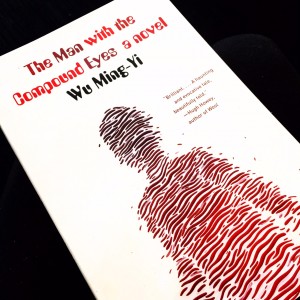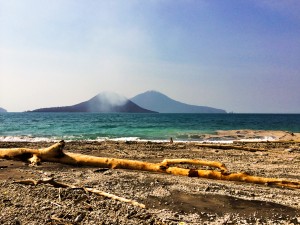Over drinks with a seismologist, I recently learned that you can hear the ocean anywhere on the planet. Anywhere. Did you know that? No matter where you are mid-continent, as far as you can imagine from water, the rhythmic pulse of the ocean hitting the shore is present as ambient seismic noise. We can find the data hidden in the sound. It is an earthquake-free form of seismology. The seismic waves are named Love, which though taken from the surname of their discoverer seems as pleasurable as the strange and charming names of quarks to me. The focus on what was prior seen as background, insignificant, struck me in what the seismologist was doing. She found magic in what an archaeologist could have thrown out with the spoil heap were it material. Pay dirt from noise.
In The Man with the Compound Eyes: A Novel by Wu Ming-Yi, an earthquake causes a tsunami of plastic to crash upon the coast of Taiwan. The plastics are from one of the five garbage vortexes/plastic gyres/anthropogenic moral quagmires currently circulating in our oceans. The gyres are described in the novel as tragicomic: in a garbage vortex you can find everything you’ve ever thrown away in your life. The TV film crews in Taiwan to record the tsunami’s landfall missed the sound of it entirely. They were too intent upon filming a freak hail storm that preceded it. The Compound Eyes book details other noises from the Earth. None of them are recorded or quantifiable. A team blasting a tunnel is haunted by the sounds of giant, telluric footsteps as they remove the core of a mountain. The ocean is described as sounding different in each place on earth and hence navigable by someone attuned to listen closely enough from the bottom of a boat rather than above deck.

Indigenous refugees without boats cling to the vortex plastic in Wu Ming-Yi’s book, using it as a life raft. It makes me think of the natural ‘rafts’ made from pumice found decades after the cataclysmic tsunamis in 1883 from the volcanic eruption of Krakatau off the coast of Java. There were skeletons on them. Unnatural plastic rafts with living people, natural pumice rafts with dead people…..there’s something there my brain is trying to disentangle but can’t. I instead think of what it must have been like to hear the 1883 Krakatau eruption. It was the loudest sound ever heard in modern history, so loud ‘that it’s inching up against the limits of what we mean by “sound” ’. The sound signified the death of at the very, very least 36,000 people but other estimates are of many multiples of that number. We will never know.

This ‘natural’ photo that I took of the shattered bits of the former Krakatau crater is a lie. It obscures the vast tangle of plastics.
I camped at the newly growing ‘child of Krakatau’ – the living, growing center of the prior crater – for a few nights with a group of volcanologists. The experience was surprisingly not disconcerting. Instead, there was something strangely spellbinding to it and its monitor lizards and toxic degassing and ominous scatter of volcanic bombs. I better understood a line from Michel Serres’ The Natural Contract when he unexpectedly felt joy in an earthquake while in Palo Alto rather than terror. The shores of the shattered Krakatau crater fragments, now islands, are lined thickly with pumice from the 1883 disaster. The pumice is completely choked with plastics. Most of them were linked to human comfort – personal items like toothbrushes and deodorants and creams – yet signify a coming species-wide discomfort. I tried taking photos of the volcanic landscape without the garishness of the plastics and began to realize that was not only futile but also dishonest. The prior disaster and the future one are snarled together there. It’s not a comfortable sound. We should probably listen.
Yes, we need to listen. Interesting. Good writing, Karen.
“The Man with the Compound Eyes” was translated into English by a previous Savage Minds guest blogger – Darryl Sterk! I’ve heard him give a talk on how he translated the descriptions of noise in the book… Darryl’s posts on indigenous film in Taiwan can be found here: /author/darryl/
Congratulations to Darryl Sterk for the vivid translation and with thanks to you, Kerim, for the entirely appropriate linkage of this piece to Darryl’s on indigenous film in Taiwan! Much appreciated.
[I also appreciate that first comment. Thanks, Mom]